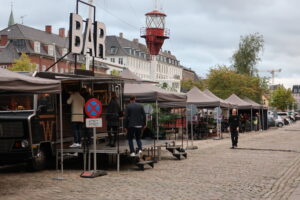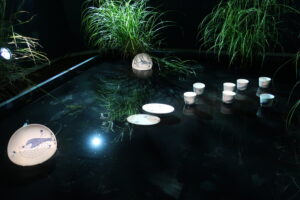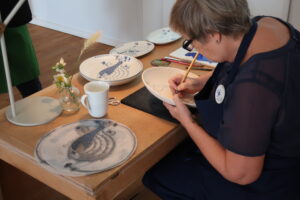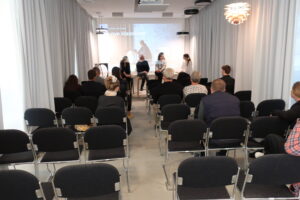デンマークの首都コペンハーゲンの街を舞台に毎年開催されている❝3 days of design❞が、今年は10月16日~18日の3日間で開催されました。
今回は現在デンマーク大使館でインターンとして来日しているラッセ・ロダール・ペダーセンが来日前に現地を訪れ取材した特別レポートをお届けします。3日間のイベントの中でも、ラッセが訪れたのは、特に日本とゆかりのあるテーマやイベントや日本国内でも展開されているブランドのショールーム等です。レポート本編は英文になりますが、下記、取材してきたイベントのテーマやブランド名等を短く紹介致します:
- DDCATED Design Hub主催のイベントから(取材順):
- 隈研吾建築都市設計事務所 池口由紀氏とデンマークの建築設計事務所Schmidt Hammer Lassen ArchitectsのKristian Ahlmark氏による対談「日本とデンマーク:共通点のある2か国のDNA」
- レストランNOMAピーター・クライナー氏、建築家兼デンマーク王立芸術アカデミー建築学校教授クリストファー・ハーラン氏、Creative Denmarkマイケン・カルハーヴ氏による対談「日本とデンマーク:デザイン、食、建築に見られる2か国のDNAの共通点」
- ロイヤル コペンハーゲン:ロイヤル コペンハーゲン本店4Fで行われた、デザインデュオGamFratesiによる最新コレクション「ロイヤル クリーチャー」のディスプレイ。並びに絵付師Helleによる手書きの絵付けのデモンストレーションの様子。
- フリッツ・ハンセン:コペンハーゲンにある旗艦店で行われたディスプレイの模様。
- Motarasu:”Black lake”をテーマにディスプレイされたデンマークと日本のデザイナーによる製品及び新作家具の発表の様子。
- ルイスポールセン:コペンハーゲンのD Studioを会場に行われたディスプレイの様子。
ラッセによるレポートと写真の数々で、コペンハーゲン現地の雰囲気が少しでもが伝われば幸いです。
Special report from “3 days of design” in Copenhagen
From the 16th to 18th October, there were three days of design in Copenhagen. It is an annual design event hosted in the Capital of Denmark. Here is showcased a realm of lifestyle, design, furniture, lighting, and interior design. The event features notable brands from Denmark and Scandinavia and takes place all over Copenhagen.
DDCATED Design Hub
 DDcated transformed the rooms of Kongernes Lapidarium to a design runaway, where the brands and designs showcased would be mixed in with the sculptures. There were 48 brands and designers inside DDcated.
DDcated transformed the rooms of Kongernes Lapidarium to a design runaway, where the brands and designs showcased would be mixed in with the sculptures. There were 48 brands and designers inside DDcated.


In front of Kongernes Lapidarium, a huge tent was set up with a stage for open talks doing the event.
Japan and Denmark: Similar DNA

At 13oclock inside the tent, we could meet the architect, Partner, and VD of Kengo Kuma Architects Yuki Ikeguchi and Kristian Ahlmark, Partner and creative CEO at Schmidt Hammer Lassen Architects. It was an open dialog about architects involved in projects in Japan and Denmark.
Yuki explained that Kengo Kuma has two big projects in Denmark, rebuilding the HC Andersen Museum in Odense and the Water Culture house at the Paper Island in Copenhagen. When asked about these two, Yuki said the focus on the HC Andersen Museum would be a duality. There was a focus on everything having a counterpart, building an aboveground floor for public usage and a below-ground floor for showing exhibits.
The Water Culture House is a former food court and will include a swimming pool, Sauna, Baths, and you name it. Yuki said, “We got to work with a truly organic, moving, material such as water, as a part of the architecture – the spacing making effect it is almost a phenomenon”.
Kristian is currently working with private developers in the Japanese city Fukuoka and creating office buildings for downtown areas. The buildings will have components of open space, retail, and connectivity between sub-terrain and metro life.
When Yuki was asked why she decided to work with Denmark, she answered that Japan and Denmark share many values. Both countries appreciate crafts and carpentry, which is the core of both nations’ construction culture. In other countries, construction becomes all business, while Japan and Denmark have a very proud way of working in carpentry, stonework, etc. Both nations share a long history of respect for the professions of crafting. Both cultures have a refined work and aesthetic and an appreciation for durability, and these values somehow create a synergy. Even though there are many shared values, the results differ from each other. And Yuki believes that Kengo Kuma’s design was chosen because it is similar yet different. The simplicity is shared, but it is more robust and bolder in Denmark, which is easy to see in Danish Design.
While talking about the differences, Kristian noted an example of how the two architects had reacted differently to the tent the open talk was in:
“This is my theory, but there is something I find quite interesting, about the way you describe architecture. Even when you came to this space, like, I came, and I saw a tent, and I was like ‘why are we in a tent?’ and you immediately spoke about you found it a cute space, and the sensibility of the space.”
The talk continued and moved on to the subject of social architects. When Yuki was asked about social architects, she answered that she believes the Japanese have a lot to learn from the Danish about this topic. Yuki continues explaining there is a great sense of public space present in Denmark, or maybe all Nordic countries. This public space is achieved with a shared understanding and joint contribution from the government, the institutions, the community, and the city. It is for everyone, and everyone helps run it. In Japanese society, this is not seen often due to more focus being on security. There is still common ground and space in Japan, just on a smaller scale than Denmark.
Lastly, Yuki was asked whether she could see an opening in exchanging knowledge between Japanese architects and danish architects, and she said:
“yes, yes, absolutely. I believe that one of my biggest interests is achieving the perfect public place. That is something we can learn from Danish design and work with the contractors from Denmark. There are, of course, similarities, but there are also differences”.
DNA Similarities, Food, Design, and architecture
At 16oclock, there was an open dialogue between the CEO of Restaurant NOMA Peter Kreiner, Professor and Architect Christoffer Harlang, and The Royal Academy of Fine Arts and CEO of Creative Denmark Majken Kalhave. They discussed the similar DNA between Japan and Denmark, but this open dialog focused more on creativity.

The moderator started by asking, “What is it we can do, what do we do differently?”
“I think, to find what we do differently, we have to look at where we come from. The society we have, the society we have grown up in, comes from democracy, collaboration. We are amazing at working together, and we work well across the hierarchy. A good idea can come from anyone. That means a lot when looking at innovation. We are also good at combining aesthetic, functionality, and story-telling.” Explained Majken.
“There is a willingness to try something new in Denmark. Our society shows the ‘creative Denmark’ when we design a restaurant, it’s not just the food; it’s architecture, design, tactile,” explained Peter
“It reminds me of a story, a Danish and an Italian furniture architect sees a chair. The Italian architect sits on the chair and hopes that he looks good. The Danish architect picks up the chair and turns it over to see hows it is made. The Danish wants the products to be proper and be in balance” Added Christoffer. Christoffer continued, “An English architect said, a good house is a house that makes you feel like an improved version of yourself.”
Next, they discussed what made Denmark unique in the world. Christoffer started explaining: “There is something simply wonderful when traveling the world as an architect, places such as Noma or other danish designs, movies, etc., helps open the door and makes people already familiar with Danish style. When I was younger, you could brag about coming from a country that made B&O and Lego, and now it’s Noma and Danish movies that are known in the whole world. Where even in this tiny country, we can set very high standards in a wide, wide net in multiple cultures, including food”.
Later on the topic of Danish architecture being popular in the world, Christoffer said:
“I think the reason Danish architecture works is that it is both exclusive and inclusive. It is exclusive because we know what we want, and we are very strict about that. It is inclusive because everybody interested can enjoy it, not just for the rich or top privileged”.
To this, Majken added:
“I’d like to add to the part about being inclusive. When we brand Denmark in the world, we like to call it “acceptable luxury”. Our society is so well designed that even the most expensive parts of Denmark have public spaces to exercise, etc. Like how we want to reduce the number of cars, one way is to make cars very expensive, but another way is to make bicycling fun. To make it an adventure to take the bike to work. To create a society where it is attractive to bicycle, where cycling makes me smile. That is what many international guests look at us and say, ‘I want that'”.
“For that to work, we also need business to be more willing to spend money and take risks on architects to innovate and make the city better,” said Christoffer.
“I believe there are many in Danish society who is willing and eager to take chances on artists”, Peter added.
“Please give me their number afterward,” said Christoffer jokingly, making the audience laugh.
Christoffer continued:
“I do feel like we have a cultural obligation to find new and young talents and take risks on them. They might not earn a lot in the first few years, but the businesses need to be willing to take risks on them.”
Majken shared that she believed many companies are already focusing on being run by their designers
and architects.
The last topic was that many cultures are asking for danish design. Why is that? Christoffer opened: “We got a planet that is overloaded, brought out of balance because of all the junk.
That means we need a different culture to fix this, a more proper, more beautiful, more loving, warmer, more balanced, and more responsible approach, and that is what is Scandinavian-ness. That is why it has never been sexier to be Scandinavian than right now”.
Majken added, “What is the theme when talking about Denmark and the Scandinavian countries? Not surprisingly, its sustainability, quality of life, digitalization, and it is about partnerships. We are among the world’s most digitalized societies. There are international agendas and goals where we are well versed, and that is our strength”.
DDcated lounge
After 18:30, the tent at DDcated transformed into a lounge and izakaya area for social networking and hygge.



With the chairs from the earlier talks turned around in circles and the bar serving cold drinks, the mood quickly became more relaxed. Morten Hove Lasthein and Anders Sælan were in the booth, while Christian Lystager was the guest DJ of the evening.

Location:
Frederiksholms Kanal 29
1220 Copenhagen K
www.ddcated.dk
Royal Copenhagen

On the 4th floor on Amagertorv 6, Copenhagen, Royal Copenhagen showed their newest collection, “Royal Creatures.” With a beautiful display of their latest collection in the water.

It is a nine-piece dinnerware collection by designer duo GamFratesi focusing on creatures from the shore, shallow waters, and the deep ocean. At the end of the 4th floor, you could find Helle, hand-painting plates for the new collection. Helle explained that all royal Copenhagen items were hand-painted, and this was an excellent opportunity to see her steady hand at work.
Location:
Amagertorv 6
1160 København
www.royalcopenhagen.com
Fritz Hansen
Doing the 3daysofdesign event, Hansen Fritz showed the season’s newest designs at their flag store in Copenhagen.

Here you see the newest updated version of the classic Oxford chair. Standing next to it is other older, as well as new designs. The configuration of this Oxford chair is Vidar textile and brushed aluminum base.

Besides their updated Oxford chairs, Fritz Hansen also shows their new lamp: The Clam Pendant. Described as a “pearl of light,” designed by the Danish design duo Ahm & Lund seashells inspire the lamp. Its shape, like an oyster, lights up the room.
Location:
Valkendorfsgade 4
1151 København K
www.fritzhansen.com
Motarasu
Under the theme “Black lake,” Motarasu showed their new beautiful furniture inspired by Danish and Japanese design fusion. I was lucky enough have a conversation with the founder of Motarasu, Mikkel Zebitz, who, when asked about the beginning of Motarasu, told me:
“It’s always just been me. I started about two years ago, well two and a half years, and I started in Vesterbro. In the early phases, I would 3D print the furniture instead of using ‘real’ materials. I was also a part of the 3daysofdesign event last year, in Østerport.”
How would you explain the differences between Japanese and Danish design?
“First of all, if you talk about Danish and Japanese design, remember it is not a homogeneous mass. For example, Japan also has a lot of crazy culture with youth culture and how some dress. That is far from the beautiful temples in the mountains. But I think that is the fascinating part, how wide the Japanese culture is. I believe danish design is a bit more homogeneous, but we are also more flamboyant. The obvious similarities we have in common are three things: Simplicity, functionality, and craftsmanship. Both nations have a big focus on using their limited resources. For example, In Japan, they have done a lot with their cedar trees.”
When discussing Motarasu’s earlier display in The Danish Embassy in Tokyo, Mikkel added this:
“Yes, I had a great opportunity at the embassy, which also leaves a statement, that is very important to me since this is the first brand which is a fusion between Danish and Japanese design like this.”
Where do you produce the Motarasu furniture now that you have moved on from the 3D printer?
“Most of it gets produced here in Denmark. But some of them are made in Japan. For example, these spoons are from the Niigata prefecture, they are famous for their work with steel through many thousand years, and I find that interesting”.


“Of course, these beautiful lamps are handmade by the artist himself, who lives south of Tokyo. In that case, I don’t produce them; I help distribute the lights. It is the only exception I have made because I find the visual aesthetic and beautiful. They are so unique, and they deserve to be shared across the globe”.
“Motarasu means change, and I would simply like to change the way Japan and Denmark interact. We have looked to each other for many years for design, but with this, it becomes collaboration”.
Can you tell me a bit about the showroom design?
“We tried to aim for what we call “your moment of zen.” Our inspiration was a forest lake on a cloudy day, where the water looked black to the human eye. We have used a high gloss floor, then we have the lines in the wood, which gives the effect of rings in the water. We have tried to, very subtly, bring nature into an old building on the fourth floor in the middle of Copenhagen. It is a foundation for our materials since we all use pure raw materials and natural materials. You also do not have to wonder how any of the furniture is made, and nothing is “over-padded,” so you can see what material the furniture is made of. Art, nature, and spreading joy are essential to me, so we chose this theme. I want the pieces we put on the market to be aesthetic and functional. I prefer to use earth colors, and I wish to keep doing that, focus on the beech and walnut. I aim to make pieces that are both beautiful and functional, and this is what I wish to share with the world.”

Is it true that nature has gotten closer to design lately? Companies seek more to bring daylight and nature into the work environment as well as the home?
“Yes, this is true, luckily other designers also focus on this. A thing I love, and think is terrific about Japanese architecture is these small courtyards. They don’t use many square meters. Maybe it is just a wall to create access to air, light, and nature. It’s incredible, and I wish I could get a house with that. Because then you can, even in the middle of Tokyo, and with little square footage, create this fantastic piece of art. The nature in the center of the town becomes the art. Of course, we cannot all live like that, but there are other ways to get the outdoors into the house, such as when people use our benches or stools.
How have 3daysofdesign been this year?
“It’s been pretty wild, and I moved into a different showroom since last year’s event. That was a smaller showroom, so I decided to move to this one where I share it with two other brands, but then we have more space. We have the first room when you enter the floor, and I think that is perfect.”
What about Covid? Has it changed anything this year?
“Guests have mostly thought it was a bit weird, as we are one of the few countries that do not require masks at this moment. You do, however, quickly get used to it, so it’s not a problem.”
I was looking at all the beautiful pieces, is there a piece that you prefer?
“That is a difficult question. To me, it is like asking if you love your son or daughter more. I would be able to talk for hours and hours on each of the pieces here, and there are so many stories to tell. That is also why I am not doing my marketing. I do not have the time to talk about my love for furniture all day. But if you take something like the stool, with its simple form, we asked ourselves, what can we do with this shape? And suddenly, we have made a sculpture that you can also sit anatomically correct on.”
I asked Mikkel about the future and his ambition hereon forward, he said:
“The mission is pretty straightforward. It would be fantastic if we could be the light to inspire others to collaborate between Denmark and Japan. I do not believe at this point that Japanese design gets enough recognition in an international setting. This brand was born to be international. You do not need to decorate your whole house in Motarasu. You can add a few of our pieces to bring nature into your home. But I hope that one day, Motarasu becomes a big international hit so we can spread joy all over the world“.
When talking about the Danish Embassy in Tokyo Mikkel said:
“It’s a huge compliment that Motarasu is standing in the Danish ambassador’s home next to such classics as Finn Juhl.”
Location:
Frederiksgade 1, 4th floor
1265 Copenhagen K
www.motarasu.com
Louis Poulsen
On papirøen Louis Poulsen presents a beautiful showroom showing off their collection of Lamps.

There was also an open talk event, where Anne Boysen, Nina Bruun, and Anders Michelsen discussed architecture and designs history.

Next to the talking event, you could meet one worker handcrafting and folding new lamps as part of the 2021 collection from Louis Poulsen.


The lamp, Patera Oval, is the latest design in the Patera family designed by Øivind Slaatto. Øivind Slaatto is a Danish designer with a master’s degree from the Danish design school. The Patera Oval was first presented in autumn 2021 and is a new take on the circular Patera designed by Øivind Slaatto in 2015. The lamp is, as seen above, entirely assembled by hand, following the mathematic structure of the Fibonacci spiral.
Location:
D Studio, Kuglegårdsvej 13
1436 Copenhagen
louispoulsen.com
Carl Hansen & Søn
Carl Hansen & Søn showed new designs fusing classic and contemporary. Their traditional furniture was on display in their flagship store in Copenhagen for the 3daysofdesign event.
Some of the beautiful pieces were:

This lamp is a simple sculpture inspired by nature. The RF200 table lamp, designed by the Danish designer Rikke frost, is recognized for its mood lighting. This lamp comes in multiple colors and different types of wood. The one in the picture above is a white powder-coated aluminum & oil-treated oak.

The T-chair is a beautiful design created by Danish furniture architect Ole Wanscher. As a part of the 0W58 collection, the T-Chair shows a combination of respect for the materials and craftsmanship. This chair comes in: Walnut, Oil, Leather Sif 90 or Oak, Soap, Re-wool 0358.

An absolute favorite of mine is designed by the Danish design duo Fabricius & Kastholm. Besides being incredibly comfortable, this foldable lounge chair makes the atmosphere more relaxed as it feels like you brought a piece of nature inside your home. The Plico Chair is made of a mix of certified solid oak and stitched linen canvas. This model is made of Oak, Oil, Canvas natural.
Location:
Bredgade 21-23
1260 Copenhagen
www.carlhansen.com
Muuto
Muuto had their two-story showroom during the 3daysofdesign event in Østergade in the middle of Copenhagen. They presented many beautiful designs rooted in the Scandinavian design tradition.


A personal favorite is the workshop table with a linoleum tabletop making it both durable and elegant. This workshop table was designed by the Danish designer Cecilie Manz. Muuto has only recently started designing desks for the home office, and this model looks stunning with its simple design. The table comes in oak veneer or linoleum carved into a solid oak frame. Yet, the nature elements light up the room and sets and relaxing atmosphere.
Here are some other examples of beautiful Muuto designs:

Location:
Østergade 36-38, 4th floor
1100 Copenhagen K
www.muuto.com






























